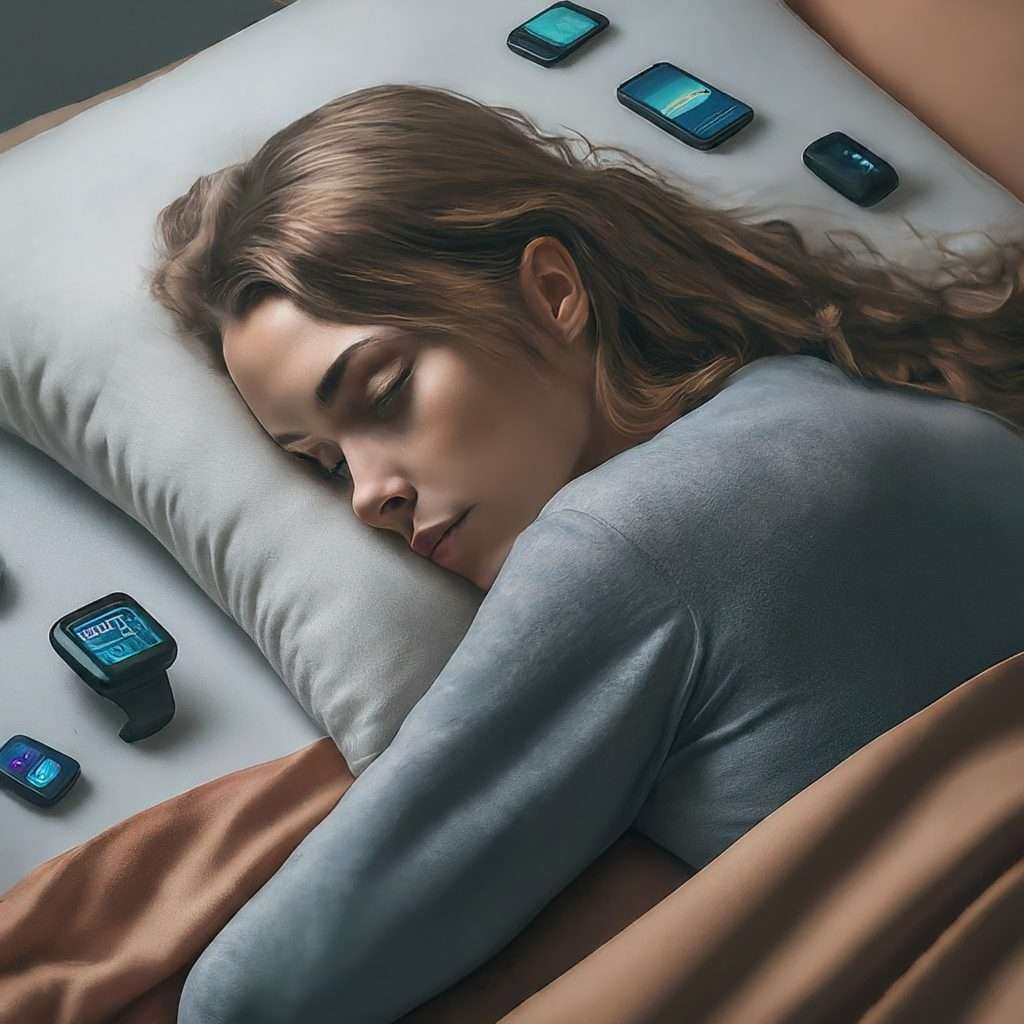Introduction
Insomnia is a common sleep disorder that affects millions of people worldwide. It is characterized by difficulty falling asleep, staying asleep, or waking up too early. Insomnia can have a negative impact on various aspects of life, such as physical health, mental well-being, productivity, and social relationships. According to the World Health Organization, about one-third of the global population suffers from some form of insomnia.
With the rapid development and widespread use of technology, many people are wondering how it affects their sleep quality and quantity. Technology can be both a friend and a foe when it comes to sleep management. On one hand, technology can provide us with tools and solutions to monitor, improve, and personalize our sleep. On the other hand, technology can also interfere with our natural sleep rhythms, expose us to harmful blue light, and create stress and anxiety.
In this article, we will explore the potential of technology in alleviating the insomnia crisis. We will examine how technology can help us understand, monitor, and treat our sleep problems. We will also discuss the challenges and considerations that come with using technology for sleep management. Finally, we will look into the future directions and possibilities of technology in enhancing our sleep health.
Understanding Insomnia
Before we dive into the role of technology in sleep management, let us first understand what insomnia is and how it affects us. Insomnia is defined as a persistent difficulty in initiating or maintaining sleep, or experiencing non-restorative sleep, that causes significant distress or impairment in daytime functioning. Insomnia can be classified into two types: primary and secondary.
Primary insomnia is when the sleep problem is not caused by any other medical or psychological condition. Secondary insomnia is when the sleep problem is associated with another underlying condition, such as depression, anxiety, chronic pain, or medication use.

The common symptoms of insomnia include:
- Trouble falling asleep at night.
- Waking up frequently during the night
- Waking up too early in the morning
- Feeling tired or unrefreshed after sleep
- Difficulty concentrating, remembering, or performing tasks during the day
- Mood swings, irritability, or depression
- Headaches, muscle aches, or gastrointestinal problems
The causes and risk factors of insomnia vary from person to person, but some of the common ones are:
- Stress, anxiety, or worry
- Lifestyle habits, such as irregular sleep schedule, caffeine intake, alcohol consumption, or smoking
- Environmental factors, such as noise, light, temperature, or bed comfort
- Biological factors, such as age, gender, genetics, or hormonal changes
- Medical conditions, such as asthma, allergies, heart disease, diabetes, or thyroid problems
- Psychological conditions, such as depression, bipolar disorder, post-traumatic stress disorder, or schizophrenia
- Medications, such as antidepressants, stimulants, corticosteroids, or beta-blockers
Insomnia can have serious consequences for our health and well-being. Chronic sleep deprivation can impair our immune system, increase our risk of developing chronic diseases, such as cardiovascular disease, diabetes, obesity, and cancer, and affect our cognitive functions, such as memory, attention, learning, and decision-making. Moreover, insomnia can also affect our emotional and social well-being, leading to reduced quality of life, lower self-esteem, impaired work performance, and increased risk of accidents, errors, and injuries.
The Role of Technology in Sleep Monitoring
One of the ways that technology can help us manage our sleep problems is by enabling us to monitor our sleep patterns and quality. There are various devices and apps available in the market that can track our sleep data, such as duration, stages, cycles, efficiency, and disturbances. Some of the common types of sleep tracking devices and apps are:
- Wearable devices, such as smartwatches, fitness trackers, or headbands, that measure our physiological signals, such as heart rate, blood pressure, body temperature, or brain activity, during sleep
- Non-wearable devices, such as bedside monitors, mattress sensors, or smart pillows, that measure our movement, sound, or breathing, during sleep
- Smartphone apps, that use the built-in microphone, camera, or accelerometer, to detect our sleep behavior, such as snoring, tossing, or turning, during sleep
By using these devices and apps, we can gain insights into our sleep habits and quality, such as how long we sleep, how deep we sleep, how often we wake up, and how we feel after sleep. We can also compare our sleep data with the recommended guidelines or norms, and identify any potential problems or areas for improvement. For example, we can see if we are getting enough sleep, if we are following a regular sleep schedule, if we are experiencing any sleep disorders, such as sleep apnea or restless legs syndrome, or if we are suffering from any sleep-related symptoms, such as daytime sleepiness or fatigue.
The benefits of sleep monitoring technology are:
- It can increase our awareness and motivation to improve our sleep hygiene and behavior
- It can provide us with objective and reliable feedback on our sleep performance and progress
- It can help us detect and diagnose any sleep disorders or issues that may require medical attention
- It can help us evaluate the effectiveness of any sleep interventions or treatments that we are using
The limitations of sleep monitoring technology are:
- It may not be accurate or valid enough to capture the complexity and variability of sleep
- It may not be able to measure the subjective aspects of sleep, such as dreams, satisfaction, or quality
- It may cause us to become too obsessed or anxious about our sleep data, leading to more stress and insomnia
- It may not be compatible or interoperable with other devices or platforms that we are using
Innovations in Sleep Therapy
Another way that technology can help us manage our sleep problems is by providing us with innovative solutions to treat our sleep disorders or improve our sleep quality. There are various technology-based sleep therapies available in the market that can deliver evidence-based techniques or interventions to help us sleep better. Some of the common types of technology-based sleep therapies are:
- Cognitive-behavioral therapy for insomnia (CBT-I), which is a psychological treatment that aims to change our thoughts and behaviors that interfere with our sleep. CBT-I can be delivered through digital platforms, such as websites, apps, or chatbots, that can provide us with personalized guidance, feedback, and support. CBT-I typically involves four components: sleep education, stimulus control, sleep restriction, and cognitive restructuring.
- Bright light therapy, which is a treatment that uses artificial light to regulate our circadian rhythm, which is our internal biological clock that controls our sleep-wake cycle. Bright light therapy can be delivered through devices, such as lamps, glasses, or masks, that can emit different intensities, colors, and timings of light. Bright light therapy typically involves exposing ourselves to bright light in the morning and avoiding bright light in the evening.
- Sound therapy, which is a treatment that uses sound to induce relaxation, distraction, or stimulation, depending on our sleep needs. Sound therapy can be delivered through devices, such as speakers, headphones, or earbuds, that can play different types of sounds, such as music, white noise, nature sounds, or binaural beats. Sound therapy typically involves listening to soothing or calming sounds before or during sleep, or listening to alerting or energizing sounds after waking up.
By using these technology-based sleep therapies, we can benefit from the proven effectiveness and convenience of these techniques or interventions. We can also tailor these therapies to our individual preferences, needs, and goals, and monitor our outcomes and feedback.
The benefits of technology-based sleep therapies are:
- They can offer us a safe, non-invasive, and non-pharmacological alternative or complement to conventional sleep treatments, such as medication or surgery
- They can provide us with access to high-quality and affordable sleep care, especially for those who live in remote areas, have limited resources, or face stigma or barriers to seeking professional help
- They can empower us to take control and responsibility of our own sleep health, and encourage us to adopt healthy sleep habits and behaviors
The limitations of technology-based sleep therapies are:
- They may not be suitable or effective for everyone, depending on the type, severity, or cause of our sleep problem
- They may require us to have a certain level of motivation, commitment, or self-regulation to use them consistently and correctly
- They may not be able to address the underlying psychological or emotional issues that may contribute to our sleep problem, such as stress, anxiety, or depression
AI and Personalized Sleep Solutions
A third way that technology can help us manage our sleep problems is by leveraging the power of artificial intelligence (AI) to provide us with personalized sleep solutions. AI is a branch of computer science that aims to create machines or systems that can perform tasks that normally require human intelligence, such as learning, reasoning, or decision-making. AI can be applied to various aspects of sleep management, such as data analysis, recommendation, and intervention. Some of the common types of AI-driven sleep solutions are:

- Wearable devices, such as smartwatches, fitness trackers, or headbands, that measure our physiological signals, such as heart rate, blood pressure, body temperature, or brain activity, during sleep
- Data analysis, which is the process of using AI to collect, process, and interpret our sleep data, such as from our sleep tracking devices or apps. AI can use advanced techniques, such as machine learning, deep learning, or natural language processing, to analyze our sleep data and extract meaningful insights, patterns, or trends. For example, AI can identify our sleep stages, cycles, or events, and compare them with the normative or optimal values.
- Recommendation, which is the process of using AI to provide us with personalized sleep advice, tips, or Intervention, which is the process of using AI to deliver personalized sleep solutions, such as devices, apps, or therapies, that can help us improve our sleep quality or quantity. AI can use adaptive techniques, such as reinforcement learning, neural networks, or genetic algorithms, to optimize and personalize our sleep solutions based on our sleep data, preferences, needs, and goals. For example, AI can adjust the intensity, color, or timing of light therapy, the type, volume, or frequency of sound therapy, or the content, pace, or duration of CBT-I.
By using these AI-driven sleep solutions, we can benefit from the intelligence and flexibility of AI to provide us with customized and optimized sleep solutions. We can also interact with AI in a natural and intuitive way, such as through voice, text, or gesture, and receive feedback and support from AI in a human-like and empathetic way.
The benefits of AI-driven sleep solutions are:
- They can offer us a smart, dynamic, and personalized sleep experience that adapts to our changing needs and goals.
- They can provide us with a user-friendly and engaging sleep interface that enhances our motivation and satisfaction.
- They can leverage the power of big data and cloud computing to provide us with scalable and reliable sleep solutions that can learn from and improve with the collective data and experience of other users.
The limitations of AI-driven sleep solutions are:
- They may not be trustworthy or transparent enough to explain how they work or why they make certain decisions or recommendations.
- They may not be ethical or responsible enough to protect our privacy and security, or to prevent any bias or discrimination.
- They may not be compatible or integrated enough with other devices or platforms that we are using, or with the existing health care system or regulations
Challenges and Considerations
While technology can offer us many benefits and opportunities for managing our sleep problems, it also poses some challenges and considerations that we need to be aware of and address. Some of the common challenges and considerations are:
- Privacy, which is the issue of how our sleep data is collected, stored, shared, and used by the technology providers or third parties. We need to be careful about what kind of sleep data we are willing to share, and with whom, and how we can protect our sleep data from unauthorized access, misuse, or abuse. We also need to be informed about the privacy policies and terms of service of the technology providers, and how we can exercise our rights and choices regarding our sleep data.
- Dependence, which is the issue of how we rely on technology for our sleep management, and how it affects our autonomy and self-efficacy. We need to be mindful about how much we depend on technology for our sleep, and how we can balance it with our own judgment and intuition. We also need to be aware of the potential risks of becoming addicted or obsessed with technology, and how we can prevent or overcome it.
- Accessibility, which is the issue of how we can access and afford technology for our sleep management, and how it affects the equity and inclusivity of sleep care. We need to consider the availability and affordability of technology for different groups of people, such as those who live in low-resource settings, have low-income levels, or face social or cultural barriers. We also need to consider the diversity and inclusivity of technology for different groups of people, such as those who have different needs, preferences, or goals, or those who belong to different ages, genders, ethnicities, or disabilities.
Future Directions
As technology continues to evolve and advance, we can expect to see more innovations and possibilities for managing our sleep problems in the future. Some of the predictions and trends for the future of technology in sleep management are:
- Wearable and implantable devices, that can measure and stimulate our brain activity, hormones, or neurotransmitters, to induce or enhance our sleep
- Virtual and augmented reality, that can create immersive and realistic environments, scenarios, or experiences, to facilitate our relaxation, distraction, or stimulation, before, during, or after sleep
- Smart home and smart city, that can integrate and coordinate various devices, sensors, or systems, to optimize our sleep environment, such as lighting, temperature, noise, or air quality
- Blockchain and cryptocurrency, that can enable secure and transparent transactions and incentives, to reward or motivate us for improving our sleep health or behavior
- Social and gamified platforms, that can connect and engage us with other users, experts, or communities, to share, learn, or compete, for enhancing our sleep knowledge, skills, or performance
Conclusion
In conclusion, technology can play a significant role in addressing the insomnia crisis that affects millions of people worldwide. Technology can help us understand, monitor, and treat our sleep problems, and provide us with innovative and personalized sleep solutions. Technology can also offer us many benefits, such as safety, convenience, accessibility, and empowerment, for improving our sleep health and well-being. However, technology also comes with some challenges and considerations, such as privacy, dependence, and accessibility, that we need to be mindful of and address. Moreover, technology can also open up new horizons and opportunities for enhancing our sleep experience and quality in the future. Therefore, we should embrace technology as a valuable and powerful ally in our quest for better sleep, but also use it wisely and responsibly, and in balance with our own natural and human capabilities.
Further Reading
- Sleeping Well in the Digital Age
- American Academy of Pediatrics: Media and Children Communication ToolkitExternal link:open_in_new
- American Academy of Pediatrics: Family Media PlanExternal link:open_in_new
- Fitness Gemini Style: Workouts for the Curious and Adaptable
- The Stress Epidemic: Simple Strategies to Manage and Reduce Stress
